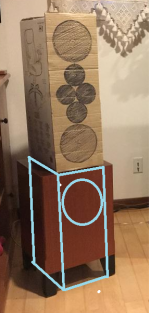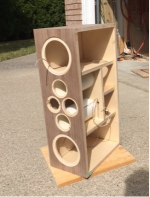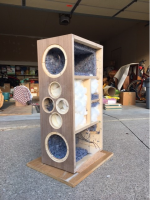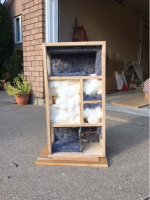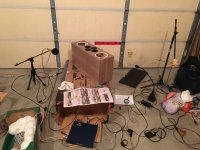project kick off and grill question
Pulled the trigger and ordered the drivers. After all deliberation: what is the fun in doing a conventional 3-way or 4-way? the world is full of different choice drivers with run-of-the-mill designs with typical XO points.
Here I will find out if merging 3 smaller drivers can be done successfully. If not, they are still very good drivers and the overall config could be changed.
The only concerns are: with a wide dispersion design I need to pay attention to the room. There is some talk at home about replacing open book shelves with closed cabinets 🙁/ Baaad idea.
Also for testing speakers with other audience, the best would be to have a grill hide the drivers. I have never used a grill and I am struggling to figure out how to do one. I do not want a wooden frame around helping diffract sound. The best would be some kind of wire frame maybe half inch in front with a stretched cloth?
Any ideas please feel free to share. Thx.
Pulled the trigger and ordered the drivers. After all deliberation: what is the fun in doing a conventional 3-way or 4-way? the world is full of different choice drivers with run-of-the-mill designs with typical XO points.
Here I will find out if merging 3 smaller drivers can be done successfully. If not, they are still very good drivers and the overall config could be changed.
The only concerns are: with a wide dispersion design I need to pay attention to the room. There is some talk at home about replacing open book shelves with closed cabinets 🙁/ Baaad idea.
Also for testing speakers with other audience, the best would be to have a grill hide the drivers. I have never used a grill and I am struggling to figure out how to do one. I do not want a wooden frame around helping diffract sound. The best would be some kind of wire frame maybe half inch in front with a stretched cloth?
Any ideas please feel free to share. Thx.
still playing (on/off) with the design in Vituix. I changed the top 3-way section so the sensitivity is up and I got it nicely sloping down on axis. Paid some price in off-axis dispersion at higher frequencies though. But a lot of that will not be known for sure until the measurements can be taken. I will be happy if I can do some woodwork this Summer the way things are going. Measurements in the Fall (best case scenario) or next year.
Still not decided on the bass section. Whether to make a bass section for each (with a Visaton AL200) or try to get away with a single sub. Adding Visatons as planned is Ok but ideally a 3-way design would be preferred over a 4-way. However with this increased sensitivity Xover layout sections are all about 6 ohm nominal load each so combining them further may not be doable as far as amp load goes.
I am also still debating an upgrade from ACAs for the upper sections' amp channels (mini Alephs, maaaybe vfets, etc.).
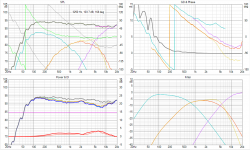
Still not decided on the bass section. Whether to make a bass section for each (with a Visaton AL200) or try to get away with a single sub. Adding Visatons as planned is Ok but ideally a 3-way design would be preferred over a 4-way. However with this increased sensitivity Xover layout sections are all about 6 ohm nominal load each so combining them further may not be doable as far as amp load goes.
I am also still debating an upgrade from ACAs for the upper sections' amp channels (mini Alephs, maaaybe vfets, etc.).

still making improvements in the model: very satisfied with recent progress.
managed to introduce some passive Xover in addition to active to reduce the speaker to 3-way. So now all 3 ScanSpeak 10Fs and the 3/4inch tweeter can be driven by one amp 🙂. The model so far accounts for this section and the one below (2 x7inch 18W SS driver) and each looks like it should be a well behaved 4-ohm speaker. Here I added the impedance plots for each and the sum phase change.
The question remaining is designing the bottom bass section. The tentative plan is to have one Visaton AL200 in a ~30L sealed box boosted by a separate amp to enough bass say under 80Hz or so to match the top portion of the speaker which is to run pretty sensitive.
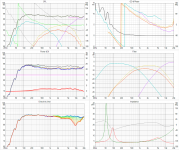
managed to introduce some passive Xover in addition to active to reduce the speaker to 3-way. So now all 3 ScanSpeak 10Fs and the 3/4inch tweeter can be driven by one amp 🙂. The model so far accounts for this section and the one below (2 x7inch 18W SS driver) and each looks like it should be a well behaved 4-ohm speaker. Here I added the impedance plots for each and the sum phase change.
The question remaining is designing the bottom bass section. The tentative plan is to have one Visaton AL200 in a ~30L sealed box boosted by a separate amp to enough bass say under 80Hz or so to match the top portion of the speaker which is to run pretty sensitive.

Last edited:
need help with the bass section please
Well I ordered the wood which should mean that after a 6 month break the project is hopefully about to pick up pace 😉. Now I will put in my time to deal with the unique upper section to see if and how well combining the three ScanSpeak 10F drivers with the tweeter and the two 7-inch midbasses works (midbasses: SS 18W-8434g00). It looked promising when modeling but only the real measurements and the listening will tell. This should keep me busy this Fall.
For the lack of time though I could really use some HELP PLEASE for the bass section which will be placed under.
I have it fixed (for the looks of course) at ~34L volume (minus the tbd driver plus the apparent volume from the acousta-stuff filling).
Internal dimensions in inches are 8-1/8 (W) x 19-1/2 (H) x 13-1/2 (D), so an 8 inch driver could fit on the front or maybe a 10 incher on the side (front mounting is probably preferred though); or maybe by some stretch a slotted design with two 8-inchers side mounted and facing each other?
See the curves up for crossing to the top section at appx. ~80Hz. The system will be active and the bass can be boosted by a separate amp and EQed.
I have a pair of AL200 Visatons left which are really great midbasses but I feel that IF! the (expensive) upper section works I should maybe invest into a real pro bass driver for the bottom section to hopefully save myself the use of an added sub.
What drivers would you recommend for this application?
Well I ordered the wood which should mean that after a 6 month break the project is hopefully about to pick up pace 😉. Now I will put in my time to deal with the unique upper section to see if and how well combining the three ScanSpeak 10F drivers with the tweeter and the two 7-inch midbasses works (midbasses: SS 18W-8434g00). It looked promising when modeling but only the real measurements and the listening will tell. This should keep me busy this Fall.
For the lack of time though I could really use some HELP PLEASE for the bass section which will be placed under.
I have it fixed (for the looks of course) at ~34L volume (minus the tbd driver plus the apparent volume from the acousta-stuff filling).
Internal dimensions in inches are 8-1/8 (W) x 19-1/2 (H) x 13-1/2 (D), so an 8 inch driver could fit on the front or maybe a 10 incher on the side (front mounting is probably preferred though); or maybe by some stretch a slotted design with two 8-inchers side mounted and facing each other?
See the curves up for crossing to the top section at appx. ~80Hz. The system will be active and the bass can be boosted by a separate amp and EQed.
I have a pair of AL200 Visatons left which are really great midbasses but I feel that IF! the (expensive) upper section works I should maybe invest into a real pro bass driver for the bottom section to hopefully save myself the use of an added sub.
What drivers would you recommend for this application?
Attachments
Last edited:
The idea that a sub is meant to add bass where there was no bass before, is the way when you're trying to hide speakers by making them small. The modern hifi definition is usually more about dealing with room modes and so 1 is usually not as good as 2.
On that note, if your mains can do 80Hz then they are just about OK as they are, meaning you can either put a sub underneath or somewhere else. If this is your first time doing this style then I can understand starting out with it underneath. At least this gives you the opportunity to mess with crossing them and deciding how low to run the mains. The main thing will be making sure it can move enough air.
On that note, if your mains can do 80Hz then they are just about OK as they are, meaning you can either put a sub underneath or somewhere else. If this is your first time doing this style then I can understand starting out with it underneath. At least this gives you the opportunity to mess with crossing them and deciding how low to run the mains. The main thing will be making sure it can move enough air.
No I get that. I normally use 12inch subs. E.g. the veneered box on legs you can see in the picture has a bottom firing 12incher. And I get the placement since I have been at Geddes's home and he is all about a matlab script optimizing a multi-sub placement etc. However I wanted to make these speakers as self-sufficient as possible and have them off the floor on a box of the same width and finished in the same veneer, so an 8 inch driver will be added. I could do ported with Visaton AL200 down to 40Hz but would also consider a better LF driver for the heavy duty work (and save those for a midbass application).
two 7-inch midbasses works (midbasses: SS 18W-8434g00).
For the lack of time though I could really use some HELP PLEASE for the bass section which will be placed under.
What drivers would you recommend for this application?
In theory dual 18W = 137*2 = 274 cm^2
Drop an octave = 4x power required = 4*274 = 1096 cm^2 = [4] 10"/channel based on size restrictions. Side mounting is normally not a problem with < ~120 Hz/2nd order XOs IME.
Considering BW, etc., only inexpensive vented woofers with highest Xmax, but sealed/DSPed to blend in room.
No clue.
I got over edge diffraction for the 18W drivers where the one on top has practically same distance to three of the edges: I crossed a bit lower and I also introduced an active shelf for the baffle step in the model (these drivers will be driven with active filters only so there is freedom to do anything).
However, what is killing me is off axis dips in 3-6kHz region where the smaller upper mids (10F8424) are working with a passive Xover. I first thought this was due to the one 10F driver which is offset horizontally and side-by-side with the tweeter. So I already decided to not use that driver and just do MTM with the other two which are vertically aligned. This of course would mean loss of sensitivity in this section, attenuating tweeter and boosting the mid-tweet channel by 6dB active gain to match the higher output from 2x18W8434 drivers used up to 650Hz.
However this morning while freezing my b&#% I took measurements and the dips are still there 😕. so back to the drawing board I guess. Not sure if the tweeter horizontal offset is the issue but there is none at higher frequencies where the response climes back up. I have to sleep on it before I try something else. Any ideas?
In VCAD model there is such a dip but lower at ~1kHz so not sure how related to the real issue higher in freq this is. The dip in the model is also persistent and I found no way of affecting it by anything tried so far.
Anyways, these are the measurements with only 2 of the 10Fs working plus the tweet. 10Fs start at 650Hz and cross with the 3/4 inch tweeter close to 5kHz (so some combing would be expected but not the 10Fs beaming so soon). (neglect the noise around 10kHz from my laptop cooling)
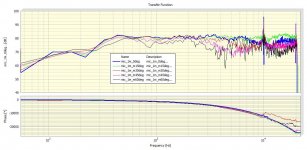
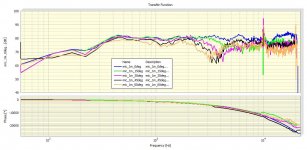
However, what is killing me is off axis dips in 3-6kHz region where the smaller upper mids (10F8424) are working with a passive Xover. I first thought this was due to the one 10F driver which is offset horizontally and side-by-side with the tweeter. So I already decided to not use that driver and just do MTM with the other two which are vertically aligned. This of course would mean loss of sensitivity in this section, attenuating tweeter and boosting the mid-tweet channel by 6dB active gain to match the higher output from 2x18W8434 drivers used up to 650Hz.
However this morning while freezing my b&#% I took measurements and the dips are still there 😕. so back to the drawing board I guess. Not sure if the tweeter horizontal offset is the issue but there is none at higher frequencies where the response climes back up. I have to sleep on it before I try something else. Any ideas?
In VCAD model there is such a dip but lower at ~1kHz so not sure how related to the real issue higher in freq this is. The dip in the model is also persistent and I found no way of affecting it by anything tried so far.
Anyways, these are the measurements with only 2 of the 10Fs working plus the tweet. 10Fs start at 650Hz and cross with the 3/4 inch tweeter close to 5kHz (so some combing would be expected but not the 10Fs beaming so soon). (neglect the noise around 10kHz from my laptop cooling)


Last edited:
and this how the two 10F drivers measure when playing by themselves before crossing to the tweeter (looks Ok I would say):
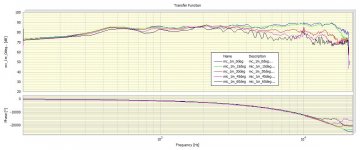
The fact that dropping the 3rd 10F driver did not fix the issue is bad news. On the other hand I am still hoping that if I could figure this out maybe I could still bring that driver back into the mix and get the sensitivity back up? right now I am up against a wall with this config though.
p.s. as far as the sensitivity: these are transfer functions amplitude normalized and phase referenced to voltage (so Pa/V); the measurement distance is close to 1m (maybe 3 inches over) and the level per 2.83V would be the measurement multiplied by 2.83, so about 9dB higher.

The fact that dropping the 3rd 10F driver did not fix the issue is bad news. On the other hand I am still hoping that if I could figure this out maybe I could still bring that driver back into the mix and get the sensitivity back up? right now I am up against a wall with this config though.
p.s. as far as the sensitivity: these are transfer functions amplitude normalized and phase referenced to voltage (so Pa/V); the measurement distance is close to 1m (maybe 3 inches over) and the level per 2.83V would be the measurement multiplied by 2.83, so about 9dB higher.
Last edited:
yep, it looks like it is all in the horizontal offsets. I got the coordinate directions wrong the first time around in VCAD and after entering X offsets correctly the dips now resemble those measured. The Xover finessing will have to wait for spring temps though for measurements outside. I may try listening to one speaker with the existing version of the Xover just to get a feel for how audible those dips may be in my room since they may not get much better by the time this gets done. a great learning experience though.
got back to the project after New Years's. Started with Xover for a WMTMW version (3rd 10F driver not used). this is possible if +6dB active gain is applied to the MTM section. I already got it to a point where it is pretty clear that it will be a fantastic speaker. The MTM section has a passive Xover and WW is on a separate active channel. I use 2x10hd miniDSP and some EQ was necessary for baffle step and the mid-tweet slope; other than that: vocals super clear, dynamics and rhythm all great! (p.s. I still cannot believe I heard my wife say: "what is different about this speaker? it is the best so far"; and I had no idea she was listening all these years 😎)
What needs a bit of work: the 3rd 10F upper mid needs to be replaced with a metal cover to cap the hole and the box padding could use some tuning.
I am so used to listening to OBs and their no-box sound that I am very sensitive to any box contributions. What makes refining the box difficult here: the fit is very tight so it takes removing WW drivers and hammering the unfinished side from the inside out to open the box each time I want to change something on the inside. This makes trying small mods in padding the box etc. not really practical. I do not even push the unfinished side all the way in so now the 3rd mid is picking up some lower freq from the WW section because the pressure leaks through the gap on that side so it acts as a mini passive radiator. A standing wave along the height also builds up and can be felt on the top of the box. However for the music material that lacks those low frequencies I can tell that the Xovers and EQ are near perfect.
There is no sign of strain from the two 10f drivers at high volumes so I am almost set to finish the speaker in this configuration. But truth be told if I knew the 3rd driver was not going to be needed I would have laid out the box volumes differently. More iterations like BR with the port instead of the 3rd driver would have also been a worthy experiment (to avoid adding a bass section under 100hz).
re: the 3-upper mid version: I am still putting together a xover for the 3x10F version since I want to learn how that config would compare (after removed gain difference). I (re)modeled it with measured drivers' sound, bought the parts and just finished the first version (the long leads in the picture are a give away; I do not cut them short on test Xovers so that any components could be reused).
What I also realized: adding a bass section under 100Hz may also call for an upgrade. The current down firing sealed 12inch subs (which I use with LX521 speakers) do not follow this upper section in terms of dynamics. This may call for going all out with something front firing, maybe even a 15incher and a big amp.


What needs a bit of work: the 3rd 10F upper mid needs to be replaced with a metal cover to cap the hole and the box padding could use some tuning.
I am so used to listening to OBs and their no-box sound that I am very sensitive to any box contributions. What makes refining the box difficult here: the fit is very tight so it takes removing WW drivers and hammering the unfinished side from the inside out to open the box each time I want to change something on the inside. This makes trying small mods in padding the box etc. not really practical. I do not even push the unfinished side all the way in so now the 3rd mid is picking up some lower freq from the WW section because the pressure leaks through the gap on that side so it acts as a mini passive radiator. A standing wave along the height also builds up and can be felt on the top of the box. However for the music material that lacks those low frequencies I can tell that the Xovers and EQ are near perfect.
There is no sign of strain from the two 10f drivers at high volumes so I am almost set to finish the speaker in this configuration. But truth be told if I knew the 3rd driver was not going to be needed I would have laid out the box volumes differently. More iterations like BR with the port instead of the 3rd driver would have also been a worthy experiment (to avoid adding a bass section under 100hz).
re: the 3-upper mid version: I am still putting together a xover for the 3x10F version since I want to learn how that config would compare (after removed gain difference). I (re)modeled it with measured drivers' sound, bought the parts and just finished the first version (the long leads in the picture are a give away; I do not cut them short on test Xovers so that any components could be reused).
What I also realized: adding a bass section under 100Hz may also call for an upgrade. The current down firing sealed 12inch subs (which I use with LX521 speakers) do not follow this upper section in terms of dynamics. This may call for going all out with something front firing, maybe even a 15incher and a big amp.
Last edited:
Very interesting work. I love this type of design. Curious what type of sensitivity gains you're getting before the crossover networks.
sensitivity with two 10F drivers used is in post #30 (~90dB/2.8V). Adding 3rd driver would allow the upper mids to catch up to 18W woofers which put out more but I am currently driving the speaker with two ACAs (i.e. 6Wmax/section only) and it is enough. Once the speaker gets finished I will try better Pass amps. The whole idea was to make a speaker which could get the best performance in each freq range from a suitably matched small size classA amp (like a VFET or mini Aleph for the mids and maybe an F5 for the woofers). The (sub)bass section will always be driven hard by a D class amp.
Off the top of my head before 2x18W (WW) I have ~-2dB active gain and ~+4dB before MTM for a total boost of ~6dB.
Off the top of my head before 2x18W (WW) I have ~-2dB active gain and ~+4dB before MTM for a total boost of ~6dB.
I think 50-60 Hz is about the upper limit to place subs away from the mains. 80 Hz is too high for my tastes and ends up being able to be located by the ear depending on the type of music. It may be ok at 80 Hz with sealed enclosure mains and the resulting better phase tracking but in most cases you can detect the separation of subs to mains if there is a phase shift present at any crossover frequency.The idea that a sub is meant to add bass where there was no bass before, is the way when you're trying to hide speakers by making them small. The modern hifi definition is usually more about dealing with room modes and so 1 is usually not as good as 2.
On that note, if your mains can do 80Hz then they are just about OK as they are, meaning you can either put a sub underneath or somewhere else. If this is your first time doing this style then I can understand starting out with it underneath. At least this gives you the opportunity to mess with crossing them and deciding how low to run the mains. The main thing will be making sure it can move enough air.
of course the intent is to have the tweeter at the listening level when sitting. so there should be a bass unit about 19-20 inches tall under the speakers. Currently I am using the sealed bass units which are too tall (by about the length of the legs in the picture). Once I finish the speaker and the box is glued all around I will establish at which frequency to cross without exciting the box too much. Currently they cross at 100Hz not to challenge the upper box too much for the reasons explained above. I have two satellite subs (also 12inch B&Cs) but I never needed them in this room in addition to these sealed units, so I do not anticipate using them, (already have enough channels and amps with this 3-way active setup).
I finished the Xover. it will be a WMTMW i.e. the 3rd 10F mid will be taken off and the hole will be capped. I tried the 3-mid version too: it had a bit more bloom and there was a degree of haziness when compared to the super clean 2-mid version; so the other one is also doable but it would have taken a lot of Xover iterations to bring that home and the incentive is not there: in the last iteration the MTM section ended up with only 3.5dB active boost so there is really no need for the 3rd mid driver. I already glued one box closed and the other one will be done this weekend. The veneer on that side will be finished when the winter is over and the temp is up in my garage. So much for going all out on the 10F mids 🙂. The internal volume ended up a bit underutilized because it was laid out with three mids in mind but that is the nature of doing something new without doing mockup boxes first.
the final version: it sounds very good crossed actively (LR4) to a sub at 120hz (a little higher than originally planned but the box resonates if pushed lower);

the EQ I added (to my taste) on top of this mid-tweet section:


the EQ I added (to my taste) on top of this mid-tweet section:
mind you: in the XO schematic 2x10F means two ScanSpeak 10F/8424G in parallel from the same Xover section. So the whole mid-tweet section (3 drivers) is nominal 4ohm load for the amp. However, from 650Hz and up it does not take much power to get really loud (I am currently running the top section with 6W/channel ACA and will try Pass Vfet amp later on).
- Home
- Loudspeakers
- Multi-Way
- Scaling up a 4inch upper mid and tweet output
